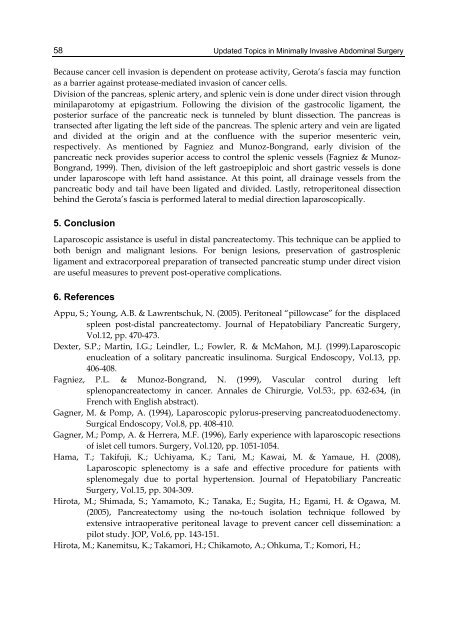UPDATED TOPICS IN MINIMALLY INVASIVE ABDOMINAL SURGERY
UPDATED TOPICS IN MINIMALLY INVASIVE ABDOMINAL SURGERY
UPDATED TOPICS IN MINIMALLY INVASIVE ABDOMINAL SURGERY
You also want an ePaper? Increase the reach of your titles
YUMPU automatically turns print PDFs into web optimized ePapers that Google loves.
58<br />
Updated Topics in Minimally Invasive Abdominal Surgery<br />
Because cancer cell invasion is dependent on protease activity, Gerota’s fascia may function<br />
as a barrier against protease-mediated invasion of cancer cells.<br />
Division of the pancreas, splenic artery, and splenic vein is done under direct vision through<br />
minilaparotomy at epigastrium. Following the division of the gastrocolic ligament, the<br />
posterior surface of the pancreatic neck is tunneled by blunt dissection. The pancreas is<br />
transected after ligating the left side of the pancreas. The splenic artery and vein are ligated<br />
and divided at the origin and at the confluence with the superior mesenteric vein,<br />
respectively. As mentioned by Fagniez and Munoz-Bongrand, early division of the<br />
pancreatic neck provides superior access to control the splenic vessels (Fagniez & Munoz-<br />
Bongrand, 1999). Then, division of the left gastroepiploic and short gastric vessels is done<br />
under laparoscope with left hand assistance. At this point, all drainage vessels from the<br />
pancreatic body and tail have been ligated and divided. Lastly, retroperitoneal dissection<br />
behind the Gerota’s fascia is performed lateral to medial direction laparoscopically.<br />
5. Conclusion<br />
Laparoscopic assistance is useful in distal pancreatectomy. This technique can be applied to<br />
both benign and malignant lesions. For benign lesions, preservation of gastrosplenic<br />
ligament and extracorporeal preparation of transected pancreatic stump under direct vision<br />
are useful measures to prevent post-operative complications.<br />
6. References<br />
Appu, S.; Young, A.B. & Lawrentschuk, N. (2005). Peritoneal “pillowcase” for the displaced<br />
spleen post-distal pancreatectomy. Journal of Hepatobiliary Pancreatic Surgery,<br />
Vol.12, pp. 470-473.<br />
Dexter, S.P.; Martin, I.G.; Leindler, L.; Fowler, R. & McMahon, M.J. (1999).Laparoscopic<br />
enucleation of a solitary pancreatic insulinoma. Surgical Endoscopy, Vol.13, pp.<br />
406-408.<br />
Fagniez, P.L. & Munoz-Bongrand, N. (1999), Vascular control during left<br />
splenopancreatectomy in cancer. Annales de Chirurgie, Vol.53:, pp. 632-634, (in<br />
French with English abstract).<br />
Gagner, M. & Pomp, A. (1994), Laparoscopic pylorus-preserving pancreatoduodenectomy.<br />
Surgical Endoscopy, Vol.8, pp. 408-410.<br />
Gagner, M.; Pomp, A. & Herrera, M.F. (1996), Early experience with laparoscopic resections<br />
of islet cell tumors. Surgery, Vol.120, pp. 1051-1054.<br />
Hama, T.; Takifuji, K.; Uchiyama, K.; Tani, M.; Kawai, M. & Yamaue, H. (2008),<br />
Laparoscopic splenectomy is a safe and effective procedure for patients with<br />
splenomegaly due to portal hypertension. Journal of Hepatobiliary Pancreatic<br />
Surgery, Vol.15, pp. 304-309.<br />
Hirota, M.; Shimada, S.; Yamamoto, K.; Tanaka, E.; Sugita, H.; Egami, H. & Ogawa, M.<br />
(2005), Pancreatectomy using the no-touch isolation technique followed by<br />
extensive intraoperative peritoneal lavage to prevent cancer cell dissemination: a<br />
pilot study. JOP, Vol.6, pp. 143-151.<br />
Hirota, M.; Kanemitsu, K.; Takamori, H.; Chikamoto, A.; Ohkuma, T.; Komori, H.;














![focuspdca.ppt [Compatibility Mode]](https://img.yumpu.com/22859457/1/190x146/focuspdcappt-compatibility-mode.jpg?quality=85)


